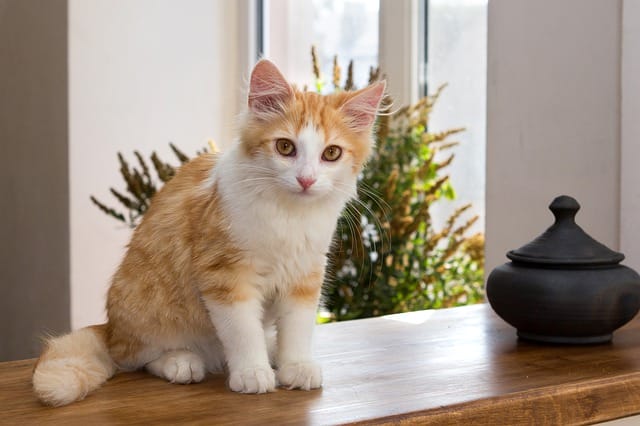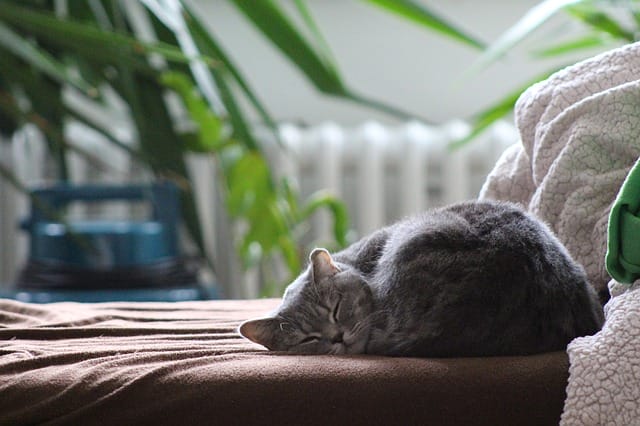
Cat hair seems to never go away, no matter how much you sweep, vacuum, and dust. The good news is that cat shedding is natural.
Excessive shedding (also known as baldness) or an increase in shedding may help alert you to underlying medical issues, so it’s crucial to understand what to look for.
Shedding is caused by the natural process of the hair cycle.
Cats are “secretive groomers” and spend at least 30% of their day grooming themselves. The only time cats cannot groom themselves is when they are sleeping.
If your cat suddenly stops grooming himself, it could be because he’s sick.
The average pet cat will shed about one pound of hair per year, and most are swallowed.
Hairballs usually occur when your cat grooms himself and swallows more hair than usual, the body cannot digest this hair and it forms a mass in the stomach.
They can also be caused by dry food or diets high in fat.
Cats are meticulous self-groomers, but they cannot swallow fur the same way they can with loose hair.
When cats lick themselves it sends a message to their brain that they need to shed, so getting them used to have you groom them may reduce over-licking behavior.
If your cat is in poor health or losing weight, your veterinarian can help assess the situation and modify or enhance his diet to improve his condition.
This may reduce over-licking behavior, but contact your veterinarian if you notice any skin lesions, sores or patches of skin becoming bare.
If your cat is getting older, the signs are often the same as in younger cats – excessive hairballs and over-licking.
Healthy older cats still shed, but it should be less noticeable.
Older cats might spend a little more time grooming themselves as they age, and this is normal as long as the skin looks healthy and there are no bare patches of skin or excessive hairballs.
Why is my cat shedding fur in clumps?

If your cat is shedding in clumps, it may be due to stress. A new baby, pet, or housemate can cause an unhappy cat to cope by over-grooming.
A new cat in the household can cause stress, so separate the cats until they are comfortable with each other.
Other times clumps of fur may be due to poor grooming habits or illness.
Look for any patches of bare skin that shouldn’t be there.
Injury, parasites, ringworm, allergies, hormonal imbalances and more can all cause patches of the skin to become bare, dry and irritated.
If your cat is exhausted from grooming himself too much, check his teeth and gums for any redness or sores.
These could be symptoms of a serious illness such as feline stomatitis or cancer, and he should see a veterinarian immediately.
How to reduce cat shedding?
If you own a long-haired cat, one of the best ways to reduce shedding and hairballs is to brush your cat daily.
It may take some time for him or her to get used to it, but this often shortens the time cats spend licking their fur instead of shedding it naturally.
Most cats don’t like brushing, but it is important to brush your cat regularly with a soft-bristled brush.
Brushing will get more of the loose hair off his coat and reduce how many hairballs he has.
If you are concerned about your cats shedding, keep their skin clean with warm water and a soft washcloth.
Bathe him as needed to keep his skin and coat clean. Also, feed a healthy high-protein diet.
- Short-haired cats need brushing once or twice a week
- Medium-haired cats need daily brushing
- Long haired cats need daily brushing with a shedding blade or rubber curry brush.
Your cat’s diet also affects the amount of hair he will shed.
Poor quality or inexpensive food with an inappropriate protein source can lead to excessive shedding because the cat is not receiving the nutrients it needs for healthy skin and coat.
Can I shave my cat to stop shedding?
A cat’s coat helps protect him from sun, cold and heat.
Shaving your cat can cause problems in these areas, so it is best to leave the shaving to a professional groomer.
Another problem with shaving your cat is that when the fur starts growing back constantly shedding will continue.
This means you’ll be constantly ridding your home of hair, so it’s best to let your cat keep his natural coat.
If you are considering shaving your cat for cosmetic reasons, consult with your veterinarian or a professional groomer before making this decision.
Conclusion
After reading this article, hopefully, you have a better understanding of why your cat is shedding fur.
Cats are very clean animals by nature, but sometimes this can turn into over-grooming or licking their skin raw.
This behavior may be due to stress, poor health or getting older. If your cat’s skin looks irritated or raw, see a veterinarian and rule out any serious health conditions.
If your cat seems healthy and happy in his environment, he might just be shedding more than usual due to seasonal changes or for other natural reasons.
You can check which cat breeds shed the most or cat breeds shed the least
- Essential Oils Safe for Cats: What Every Pet Owner Needs to Know - May 23, 2025
- Herbal Supplements for Cats: A Natural Approach to Cat Wellness - May 21, 2025
- Signs of a Healthy Cat Coat: What Every Cat Owner Should Know - May 19, 2025


GIPHY App Key not set. Please check settings